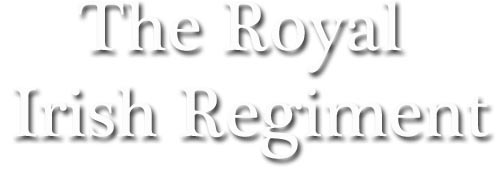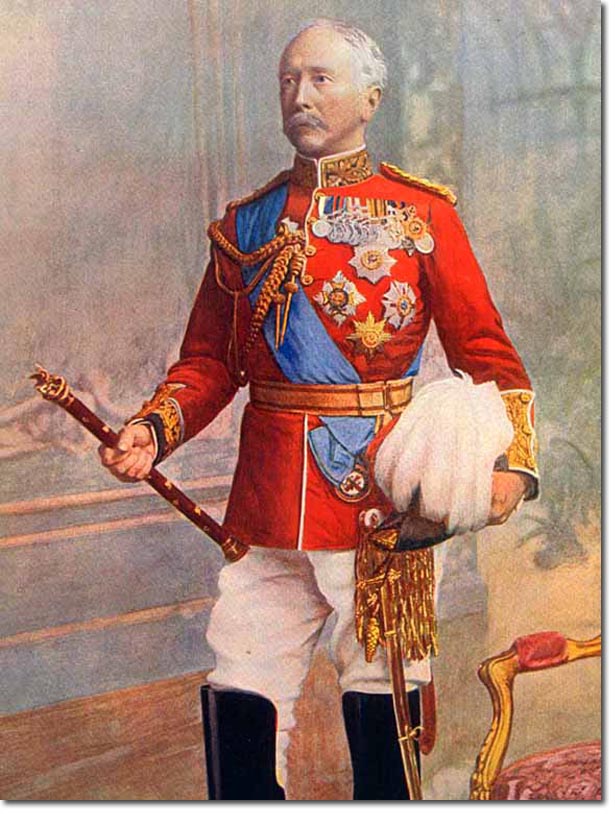|
|


|
|
Field Marshal Wolseley was appointed to the unprecedented post of Colonel-in-Chief of the Royal Irish Regiment on 20th July 1898. This honour was conferred on the regiment by Her Majesty Queen Victoria following the injustice done to the 2nd Battalion in September 1897 when they were recalled from active service in the Tirah. They were subsequently re-instated 4 months later amidst much embarrassment in the upper military establishment. The original culprit responsible for the slur was Major-General Yeatman-Biggs who died of dysentery 3 months after his shameful letter demanding the withdrawal of the battalion.
The 1st Battalion was in Curragh when they were presented with new Colours to replace the ones that had been destroyed in a fire a year earlier. On 14th Nov 1892 Lady Wolseley presented the regiment with the Colours and Sir Garnet made a speech which established his strong links with the regiment: "I served side by side with it in Burma when I was very young. I met it again in the Crimea, and I can well remember what pride I felt as an Irishman in its gallant conduct on the 18th June 1855. It also served in India whilst I was there during the Mutiny, and it must be in the remembrance of many of those who are now on parade that we were comrades together during the war in Egypt in 1882. I remember well, in the first streak of dawn on the desert of Tel-el-Kebir, seeing the Royal Irish among the first to cross the entrenchments, and again, two years later, we met on the Nile, in which expedition they played a distinguished part. I felt proud that they should have been the winners of a prize which was offered to the battalion which made the journey up the river in the shortest time. I have a very much prized trophy of the expedition which was given to me by one for whom I have the greatest respect - one of the very best men and best soldiers I ever knew - I refer to Father Brindle, your former chaplain, who accompanied you from Cairo up the river, and then across the Desert to Gubat. The trophy is the flag of the boat in which he made the voyage up the Nile; it is marked 'H Company, Royal Irish.' "Yours is one of the oldest regiments in the army. When first raised it was named 'The Regiment of Ireland'. That name was changed by William III to the Royal Irish Regiment, as a reward, a distinction for your gallant services at the taking of Namur. If I were to enter into detailed history of the regiment it would be to give a history of the British Army, for the history of one may be said to be the history of the other. I chanced to read an old book the other day, describing the wars of the early part of the last century, in which it was stated that the discipline, system of drill, and fighting training of the army then had been copied from the discipline and military system long established in the Royal Irish Regiment. As you know from the names of the battles on your Colours, you shared in all the glories of the Duke of Marlborough, and although hereafter I have no doubt you will add many names to these Colours - for we shall have wars as long as the world exists - no greater victory than that of Blenheim, or Ramilles, can ever be shared in by any regiment. Now, what is the value of all this glory to a regiment, or to the army of which it is a part? It is this, it intensifies the pride of the regiment, and the pride of the Empire to which we all belong; it is an incentive to those who come after us to imitate, and if possible, to excel the deeds of their forefathers. May Gold Bless these Colours and prosper this fine old distinguished regiment." |
Regimental Details | Charles Orr's Memoirs | Wolseley's Memoirs
Armed Forces | Art and Culture | Articles | Biographies | Colonies | Discussion | Glossary | Home | Library | Links | Map Room | Sources and Media | Science and Technology | Search | Student Zone | Timelines | TV & Film | Wargames
